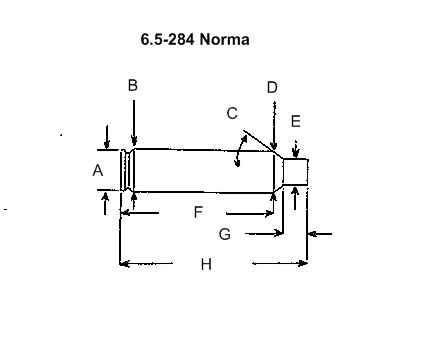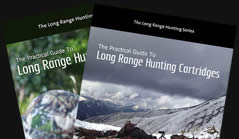6.5-284 Norma
History
When Winchester released the .284 Winchester in 1963, primarily for hunting, many competitive target shooters saw great potential in both the primary design and as a parent design for wildcatting. The .284 case was short but wide and in comparison to the .30-06 length cartridges, enabled shooters to experiment with a different shaped powder column with hopefully excellent, or at the least, interesting internal ballistics. The .284 was able to fire a 162 grain bullet between 2950 and 3050fps from a 30" target barrel however the choice of target bullets available for 7mm users during the 1960’s was rather poor.When wildcatters necked the .284 case down to 6.5 during the late 1960’s, the resulting 6.5-284 cartridge was able to fire a high BC 140 grain bullet at similar velocities to the parent .284 but with much lower recoil. With advances in 6.5 caliber bullet design and a growing understanding of suitable reloading techniques, the 6.5-284 steadily gained popularity. The wildcat produced excellent results in 1000 yard competition and eventually gained the attention of a number of hunters.
In 1999, the Norma ammunition company of Sweden adopted the wildcat naming it the 6.5-284 Norma. Brass was made available for competitive shooters who prefer to reload their own ammunition, as well as two factory loads for hunters. At this time of writing, no manufacturer produces a factory rifle chambered in 6.5-284.
Both the American Sporting Arms and Manufacturing Institute (SAAMI) and the European Commission of International Proof (CIP) have separate specifications for 6.5-284 reamers and case dimensions. American SAAMI chamber dimensions are based on .284 Winchester brass necked down to 6.5 which creates extra material thickness at the case neck. CIP dimensions are based on the Norma and Lapua brass which is thinner at the neck. Nevertheless, custom reamers are built to many varying specifications therefore it is imperative that shooters use the correct brass with the correct chamber.
Performance
The 6.5-284 is a powerful cartridge but is not without its complexities. In competition circles this cartridge is highly valued for its performance at 1000 yards but competitors find that throat erosion causes a deterioration in extreme accuracy between 700 and 1000 rounds. To some, having to re-chamber a rifle at 800 rounds is annoying. For others, re-chambering is simply normal maintenance. In recent years, with advancements in 7mm projectile design, some competitors have gone back to using the less overbore parent cartridge, the .284 Winchester. Other competitors have moved back to the 6.5x55 AI and .260AI. Those who do use the 6.5-284 and parent .284 still prefer the short fat case design over the .30-06 based cartridges due to the powder burning characteristics of the short fat case.For hunting, the 6.5-284 produces high power from short action rifles but again, this is not a clear cut issue. In a short action, VLD type projectiles, popular with long range hunters, must be seated deep in the .284 case to fit short action magazines. Velocity loss is not so much of an issue however excessive bullet jump can significantly reduce accuracy with VLD type bullets. If the rifle has it’s chamber cut short for minimum bullet jump from a short action magazine fed rifle, velocity does suffer. The 6.5-284 can of course be housed in a long action rifle but in some ways, is almost counterproductive.
Generally speaking, as a hunting cartridge, the 6.5-284 suits hunters interested in specialized long range hunting due to the technical aspects involved in chambering etc. Goal velocities for the 6.5-284 are 2950fps with 140 grain projectiles. Using an extremely soft projectile such as the 140 grain Berger VLD, these speeds produce wide wounding on medium game out to a maximum of 600 yards. At longer ranges, cartridges with a higher initial muzzle velocity produce wider wounds which for the long range hunter, should be of the same importance as accuracy.
Factory Ammunition
The two Norma factory loads are the 120 grain Nosler ballistic tip at an advertised 3117fps and the Nosler 140 grain Partition at 2952fps. As mentioned throughout the 6.5 texts, both are extremely useful projectiles and performance on game is extremely satisfying when loads are matched to the job at hand. Although Norma have distributors worldwide, Norma ammunition is not the common sight on gun store shelves that it once was. For this reason, the 6.5-284 is mostly a hand loader’s cartridge.
Hand Loading
Brass for the 6.5-284 is produced by Norma, Lapua and Hornady. Along with this, Olin still offer the parent .284 cartridge case but in some rifles this brass needs neck turning in order to avoid dangerous pressures.The 6.5-284 achieves best results with either H4350 (ADI2209) or H4831sc (ADI2213sc) powders. It would be unwise to state that one powder is better than the other due to the variations in seating depths used in the 6.5-284. H4831 is a much bulkier powder than H4350 and in most instances will give best results in a cartridge with a long COAL to prevent excessive powder space and associated inconsistencies during ignition.
From a 24” barrel, the 6.5-284 produces working velocities of 3100fps with 120 grain bullets, 3000fps with 129 grain bullets and 2900fps with 140 grain bullets. Some rifles are capable of higher velocities but it is just as common to find best accuracy at velocities lower than stated here. From 32” target barrels, competitive shooters load to velocities of around 2950fps with140-142 grain bullets. Typical maximum COAL for the 6.5-284 is around 3" with sleek match bullets, slightly shorter with hunting style projectiles.
The 3" 6.5-284 may seem a good re-chambering option for the M96 Swedish Mauser. Unfortunately there is not enough material surrounding the 6.5 barrel which measures .965" at the chamber. The 6.5-284 is however ideal for utilizing the medium length M98 Mauser action as well as the M77 Ruger long action with its otherwise limited magazine length - along with a host of other modern action designs.
For the hunter wishing to use the Mauser 98 action, the 6.5-284 with bullets seated out to 3" OAL fits easily into the 3.3" (84mm) magazine. When re-chambering to 6.5-284 it is important to have a competent gunsmith alter the magazine feed rails. This allows the fat case to sit high enough that the rebated rim can be picked up by the bolt, much attention is needed here to avoid a jamming action or in the other extreme, a loose action which allows cartridges to pop out.
Rather than reiterate normal hunting bullet performance which has been discussed in great detail throughout previous 6’5 texts, the paragraphs ahead will address match projectiles for long range hunting.
The Sierra MatchKing is available in the weights 107, 120, 123, 140, 142 and 155 grains and Sierra do not recommend the SMK as a hunting projectile. All SMK projectiles tend to be erratic performers on game. During research, it was noted that the SMK produced expansion / fragmentation on approximately 50% of the animals taken. Where expansion / fragmentation did not occur, the results were abysmal.
Lapua match offerings include the 100, 108, 123 and 139 grain Scenar projectiles. Results on game are the same as the SMK. The Scenar will often produce a pin hole sized, through and through wound, if no bone is hit. As can be expected, killing in this instance is extremely delayed and inhumane.
Hornady currently produce two fast expanding match projectiles suitable for game hunting, the new 120 grain A-Max and the tried and true 140 grain A-Max. Although the 120 grain A-Max might sound like a hot number, at the 600 yard mark, it retains less velocity and energy than its heavier counterpart. The 140 grain A-Max (BC .550) is an excellent long range hunting bullet for use on lighter medium game. The A-Max will either expand or tumble and shred depending on what it encounters during penetration, producing wide wounding out as far as 725 yards (1800fps).
Berger produce VLD bullets in the weights 130 and 140 grains. Berger are the only manufacturer to offer match style bullets specifically intended for hunting. Of these, the 140 grain VLD has a high BC of .612, producing full fragmentation at velocities as low as 2000fps (700 yards) without need of major resistance on impact. Like the A-Max, the VLD is best suited to lighter medium game due to the limitations of the 6.5mm bore diameter along with its associated bullet weights.
Closing Comments
The 6.5-284 has many strengths for 1000 yard competition shooting. As an outgrowth of this, it is not uncommon for hunters to look at these desirable features and attempt to adapt them to long range hunting. Unfortunately the two disciplines, although much the same in theory, are different. Accuracy alone is not enough to ensure fast humane killing at extended ranges. Most projectiles lose the ability to create wide wounding once the 2200fps barrier is breached. Some, like the A-Max and Berger VLD will produce fast kills as low as 2000fps. Below this velocity figure kills can be very slow with small bore projectiles if major bone is not encountered during penetration.Long range hunters should always seek to find a load that will deliver 2000fps at the target, placing retained velocity ahead of retained energy in most (but not all) cases. It is for these reasons that the 6.5-.284 is, within these pages, treated as a 600 yard cartridge if long range hunting combined with consistent humane killing is the goal.
| Suggested loads: 6.5-284 Norma | Barrel length: 24 | |||||
| No | ID | Sectional Density | Ballistic Coefficient | Observed MV Fps | ME Ft-lb’s |
|
| 1 | HL | 108gr Scenar | .221 | .478 | 3260 | 2548 |
| 2 | HL | 140gr A-max | .287 | .550 | 2950 | 2705 |
| 3 | HL | 140gr Berger VLD | .287 | .640 | 2950 | 2705 |
| Suggested sight settings and bullet paths | ||||
| 1 | Yards | 600 | 625 | 650 |
| Bt. path | 0 | -4.4 | -9.3 | |
| 2 | Yards | 600 | 625 | 650 |
| Bt. path | 0 | -5.1 | -10.7 | |
| 3 | Yards | 600 | 625 | 650 |
| Bt. path | 0 | -4.7 | -9.9 | |
| No | At yards | 10mphXwind | Velocity | Ft-lb’s |
| 1 | 600 | 21.9 | 2180 | 1139 |
| 2 | 600 | 21.3 | 2057 | 1315 |
| 3 | 600 | 17.9 | 2172 | 1466 |
Note: above data for comparative purposes only. For normal trajectory data, refer to 6.5-06.

| Imperial | Metric | |
| A | .473 | 12.01 |
| B | .500 | 12.7 |
| C | 35deg | |
| D | .475 | 12.06 |
| E | .297 | 7.54 |
| F | 1.77 | 45.08 |
| G | .268 | 6.80 |
| H | 2.170 | 55.12 |
| Max Case | 2.170 | 55.12 |
| Trim length | 2.160 | 54.8 |
Discuss this article or ask a question on the forum here
Copyright © 2007-2017 Terminal Ballistics Research, Ballisticstudies.com
|
|||||||||
|
|||||||||
FOUND THIS ARTICLE HELPFUL?If you find the resources on this website to be valuable, we would be sincerely grateful if you would consider making a donation to help us cover the costs of the website and to assist us to continue our research and testing into the future. It doesn't matter whether your donation is big or small - it makes all the difference! |
|||||||||






